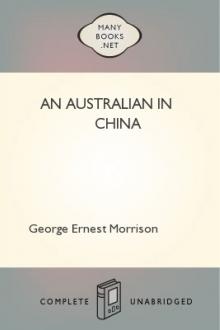Court Life in China by Isaac Taylor Headland (miss read books txt) 📕

- Author: Isaac Taylor Headland
- Performer: -
Book online «Court Life in China by Isaac Taylor Headland (miss read books txt) 📕». Author Isaac Taylor Headland
The Princess Shun and Princess Tsai Chen, only daughter-in-law of Prince Ching, herself the daughter of a viceroy, were very congenial, and the most intimate friends of all those in court circles. The latter is beautiful, brilliant, quick, tactful, and graceful. Of all the ladies of the court she is the most witty and, with Princess Shun, the most interesting. These two more than any others made the court ladies easy to entertain at all public functions, for they were full of enthusiasm and tried to help things along. They seemed to feel that they were personally responsible for the success of the audience or the luncheon as a social undertaking.
Lady Yuan is one of two of these court ladies who dwelt with the Empress Dowager in the palace, the other being Prince Ching’s fourth daughter. She is a niece by marriage of the Empress Dowager, though she really was never married. The nephew of the Empress Dowager, to whom she was engaged, though she had never seen him, died before they were married. After his death, but before his funeral, she dressed herself as a widow, and in a chair covered with white sackcloth went to his home, where she performed the ceremonies proper for a widow, which entitled her to take her position as his wife. Such an act is regarded as very meritorious in the eyes of the Chinese, and no women are more highly honoured than those who have given themselves in this way to a life of chastity.
The second of these ladies who remained in the palace with the Empress Dowager is the fourth daughter of Prince Ching. Married to the son of a viceroy, their wedded life lasted only a few months. She was taken into the palace, and being a widow, she neither wears bright colours nor uses cosmetics. She is a fine scholar, very devout, and spends much of her time in studying the Buddhist classics. She is considered the most beautiful of the court ladies.
The Empress Dowager took charge of most of the domestic matters of all her relatives, taking into the palace and associating with her as court ladies some who were widowed in their youth, and keeping constantly with her only those whom she has elevated to positions of rank, or members of her own family. Nor was she too busy with state affairs to stop and settle domestic quarrels.
Among the court ladies there was one who was married to a prince of the second order. Her husband is still living, but as they were not congenial in their wedded life, the Empress Dowager made herself a kind of foster-mother to the Princess and banished her husband to Mongolia, an incident which reveals to us another phase of the great Dowager’s character—that of dealing with fractious husbands.
XIVThe Princesses—Their Schools
The position accorded to woman in Chinese society is strictly a domestic one, and, as is the case in other Eastern countries, she is denied the liberty which threatens to attain such amazing proportions in the West. There is no reason to suppose that woman in China is treated worse than elsewhere; but people can of course paint her condition just as fancy seizes them. They are rarely admitted into the domestic surroundings of Chinese homes, therefore there is nothing to curb the imagination. The truth is that just as much may be said on one side as on the other. Domestic happiness is in China—as everywhere else the world over—a lottery. The parents invariably select partners in marriage for their sons and daughters, and sometimes make as great blunders as the young people would if left to themselves. —Harold E. Gorst in “China.”
XIVTHE PRINCESSES—THEIR SCHOOLS[1]
[1] Taken from Mrs. Headland’s note-book.
One day while making a professional call on the Princess Su our conversation turned to female education in China. I was deeply interested in the subject, and was aware that the Prince had established a school for the education of his daughters and the women of his palace, and was naturally pleased when the Princess asked:
“Would you care to visit our school when it is in session?”
“Nothing would please me more,” I answered. “When may I do so?”
“Could you come to-morrow morning?” she inquired.
“With pleasure; at what time?”
“I will send my cart for you.”
The following morning the Prince’s cart appeared. It was lined with fur, upholstered in satin, furnished with cushions, and encircled by a red band which indicated the rank of its owner. A venerable eunuch, the head of the palace servants, preceded it as an outrider, and assisted me in mounting and dismounting, while the driver in red-tasselled hat walked decorously by the side.
The school occupies a large court in the palace grounds. Another evidence of Western influence in the same court is a large two-story house of foreign architecture where the Prince receives his guests. Prince Su was the first to have this foreign reception hall, but he has been followed in this respect by other officials and princes as well as by the Empress Dowager.
“This is not unlike our foreign compounds,” I remarked to the Princess as we entered the court.
“Yes,” she replied, “the Prince does not care to have the court paved, but prefers to have it sodded and filled with flowers and shrubs.”
The school building was evidently designed for that purpose, being light and airy with the whole southern exposure made into windows, and covered with a thin white paper which gives a soft, restful light and shuts out the glare of the sun. The floor is covered with a heavy rope matting while the walls are hung with botanical, zoological and other charts. Besides the usual furniture for a well-equipped schoolroom, it was heated with a foreign stove, had glass cases for their embroidery and drawing materials, and a good American organ to direct them in singing, dancing and calisthenics.
I arrived at recess. The Princess took me into the teacher’s den, which was cut off from the main room by a beautifully carved screen. Here I was introduced to the Japanese lady teacher and served with tea. She spoke no English and but little Chinese, and the embarrassment of our effort to converse was only relieved by the ringing of the bell for school. The pupils, consisting of the secondary wives and daughters of the Prince, his son’s wife, and the wives and daughters of his dead brother who make their home with him, entered in an orderly way and took their seats. When the teacher came into the room the ladies all arose and remained standing until she took her place before her desk and made a low bow to which they all responded in unison. This is the custom in all of the schools I have visited. Even where the superintendent is Chinese, the pupils stand and make a low Japanese bow at the beginning and close of each recitation.
“How long has the school been in session?” I asked the Princess.
“Three and a half months,” she replied.
“And they have done all this embroidery and painting in that time?”
“They have, and in addition have pursued their Western studies,” she explained.
In arithmetic the teacher placed the examples on the board, the pupils worked them on their slates, after which each was called upon for an explanation, which she gave in Japanese. While this class was reciting the Prince came in and asked if we might not have calisthenics, evidently thinking that I would enjoy the drill more than the mathematics. It was interesting to see those Manchu ladies stand and go through a thorough physical drill to the tune of a lively march on a foreign organ. The Japanese are masters in matters of physical drill, and in the schools I have visited I have been pleased at the quiet dignity, and the reserve force and sweetness of their Japanese teachers. The precision and unanimity with which orders were executed both surprised and delighted me. Everything about these schools was good except the singing, which was excruciatingly poor. The Chinese have naturally clear, sweet voices, with a tendency to a minor tone, which, with proper training, admit of fair development. But the Japanese teacher dragged and sang in a nasal tone, in which the pupils followed her, evidently thinking it was proper Western music. I was rather amused to see the younger pupils go through a dignified dance or march to the familiar strains of “Shall we gather at the river,” which the eldest daughter played on the organ.
“The young ladies do not comb their hair in the regular Manchu style,” I observed to the Princess.
“No,” she answered, “we do not think that best. It is not very convenient, and so we have them dress it in the small coil on top of the head as you see. Neither do we allow them to wear flowers in their hair, nor to paint or powder, or wear shoes with centre elevations on the soles. We try to give them the greatest possible convenience and comfort.”
They were proud of their bits of crocheting and embroidery, each of which was marked with the name of the person who did it and the date when it was completed. Many of them were made of pretty silk thread in a very intricate pattern, though I admired their drawing and painting still more.
“Of what does their course of study consist?” I asked the Princess.
She went to the wall and took down a neat gilt frame which contained their curriculum, and which she asked her eldest daughter to copy for me. They had five studies each day, six days of the week, Sunday being a holiday. They began with arithmetic, followed it up with Japanese language, needlework, music and calisthenics, then took Chinese language, drawing, and Chinese history with the writing of the ideographs of their own language, which was one of the most difficult tasks they had to perform. The dignified way in which the pupils conducted themselves, the respect which they showed their teacher, and the way in which they went about their work, delighted me. The discipline it gave them, the self-respect it engendered, and the power of acquisition that came with it were worth more perhaps than the knowledge they acquired, useful as that information must have been.
The Princess Ka-la-chin, the fifth sister of Prince Su, is married to the Mongolian Prince Ka-la. It is a rule among the Manchus that no prince can marry a princess of their own people, but like the Emperor himself, must seek their wives from among the untitled. These ladies after their marriage are raised to the rank of their husbands. It is the same with the daughters of a prince. Their husbands must come from among the people, but unlike the princes they cannot raise them to their own rank, and so their children have no place in the imperial clan. Many of the princesses therefore prefer to marry Mongolian princes, by which they retain their rank as well as that of their children.
Naturally a marriage of this kind brings changes into the life of the princess. She has been brought up in a palace in the capital, lives on Chinese food, and is not inured to hardships. When she marries a Mongol prince, she is taken to the Mongolian plains, is not infrequently compelled to





Comments (0)